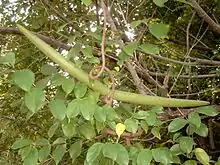Strophanthus sarmentosus
Strophanthus sarmentosus grows as either a deciduous shrub or as a liana up to 40 metres (130 ft) long, with a stem diameter up to 15 centimetres (6 in). Its fragrant flowers feature a white to purple corolla, red or purple-streaked on the inside. Strophanthus sarmentosus is native from west and central tropical Africa to Uganda and Angola.[1][2] Vernacular names for the plant include spider tresses and poison arrow vine. Its habitat is forested areas from sea level to 1,400 metres (4,600 ft) altitude.
| Strophanthus sarmentosus | |
|---|---|
 | |
| Flowers | |
| Scientific classification | |
| Kingdom: | Plantae |
| Clade: | Tracheophytes |
| Clade: | Angiosperms |
| Clade: | Eudicots |
| Clade: | Asterids |
| Order: | Gentianales |
| Family: | Apocynaceae |
| Genus: | Strophanthus |
| Species: | S. sarmentosus |
| Binomial name | |
| Strophanthus sarmentosus | |
| Synonyms[1] | |
| |
The numerous local medicinal uses of S. sarmentosus include treatment of joint pain, head lice, eye conditions and venereal disease. The plant has also been used as arrow poison.[2] Botanist John Baldwin discovered that Strophanthus sarmentosus was a natural source of the steroid hormone cortisone and was used in the early manufacture of cortisone-based drugs.[3]
Gallery
 Horn-like, paired, follicular fruits
Horn-like, paired, follicular fruits
References
- "Strophanthus sarmentosus". World Checklist of Selected Plant Families (WCSP). Royal Botanic Gardens, Kew. Retrieved 2 August 2017.
- Medicinal Plants. PROTA. 2008. pp. 557–559. ISBN 978-9-05782-204-9.
- "John T. Baldwin Jr., Botanist, 63, Dead". The New York Times. 5 September 1974. Retrieved 8 February 2020.